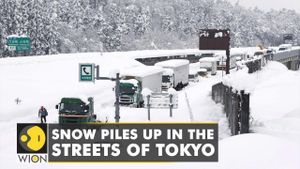A Major Snowstorm Disrupts Transportation Across Japan
Widespread travel chaos as record snowfall hits multiple regions
A heavy snowstorm has significantly impacted transportation throughout Japan, resulting in road closures, train delays, and advisories urging the public to avoid unnecessary travel. Various regions are bracing for more snow, with officials advising residents to stay informed about the latest weather and transportation updates.
On February 7, reports indicated conditions of heavy snowfall especially affecting the northern parts of Japan. According to ABEMA TIMES, extensive snow accumulation was recorded across Niigata to the southern parts of Tohoku, primarily attributed to the Japan Sea snow cloud convergence zone (JPCZ) which has intensified across the area.
Local authorities have implemented preventive measures, including road closures on major highways. The Central Japan Regional Bureau announced potential proactive shutdowns on highways expected to be hit hardest by the impending storm. This winter season’s cold air has provoked warnings of snowstorms, leading officials to caution against unnecessary travel.
By the afternoon of February 7, updates from nexco east confirmed various road closures in affected areas, impacting routes such as the Iwaki and Ban'etsu Expressways due to the snow, which has made conditions unsafe for drivers. The relevant authorities encouraged individuals to check the latest weather forecasts before planning travel.
Alongside abnormal snow conditions on the Japan Sea coastside, rain and snow are forecasted to reach central and even western Japan including regions known for minimal snowfall, like Nagoya and Kyoto. Reports predict between 1 to 10 centimeters of snow accumulation will create hazardous driving conditions leading up to February 8. CBC Television indicated warnings already issued for expected poweful wind gusts and potential blackouts alongside trapped vehicles as visibility decreases.
Transportation services have also been disrupted, particularly the JR trains, which experienced delays, especially notable on the Sanyo Shinkansen line between Hakata and Shin-Osaka. Highways from Kyushu to Tokyo saw many bus services suspended, affecting daily commutes and travel plans for many residents.
Specific advisories have highlighted the need for commuters to remain cautious and to allow extra time for their journeys, as many public transportation systems are under strain. J-CAST News detailed precautions were pushed through various communication channels including school notifications cautioning children to dress warmly and prepare for potential delays.
On February 8, more snowfall is anticipated, particularly targeting the Tokai, Kinki regions, and parts of Shikoku and western Japan, which have seen little precipitation recently. Accumulated snow will put local infrastructures to test as cities implement countermeasures against slippery conditions and traffic disruption.
The Central Japan Region has already begun to take action, with preparatory measures for heavy snow expected to significantly affect logistics and supply chains. The dire conditions have also prompted communications to the public to alter their travel plans or seek alternate routes to avoid trouble. This proactive response aims to keep public safety at the forefront of any potential travel during harsh weather.
Residents and travelers are advised to stay informed through updated forecasts, including following NHK News and other reliable sources for the most recent alerts and recommendations. With authorities reiteratively emphasizing the risks associated with winter travel, there is heightened awareness of weather-related safety precautions following previous severe challenges presented by unpredictable winter weather.
For drivers, safety measures include equipping vehicles with winter tires and being equipped for emergencies, keeping essentials and safety kits on hand. Foot traffic also demands care; the public is reminded about adopting the appropriate walking techniques to navigate slippery surfaces safely - small steps, maintaining balance with slightly bent legs, and utilizing hands for support where necessary.
Current forecasts continue to predict fluctuated temperatures, with dry spells and sudden cold snaps leading to icy formations later, particularly at night. According to Tenki.jp, icy patches form unexpectedly even when the surface appears clear, signaling to maintain readiness for potential dangers during the winter season.
This looming snowstorm serves as a potent reminder of nature's unpredictable patterns, urging swift action from local and regional transport agencies to protect the public and maintain functional networks during adverse weather.



